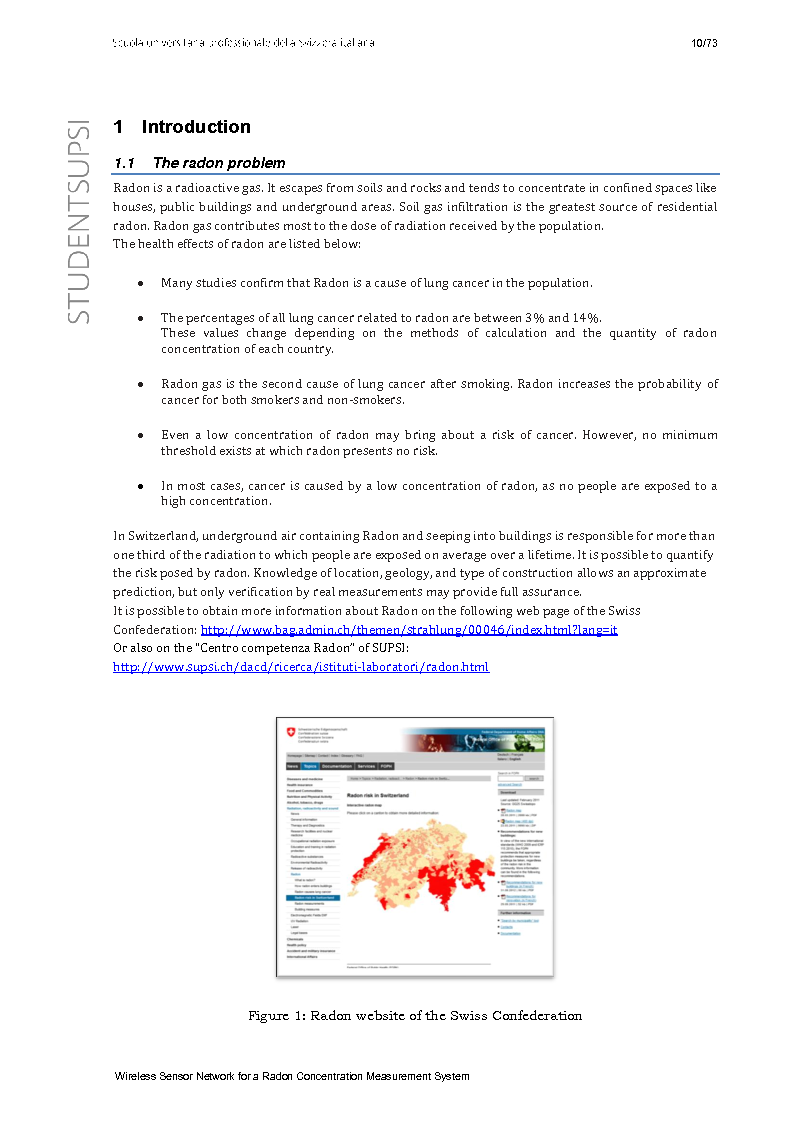Wireless Sensor Network fo a Radon Concentration Measurement System
Wireless sensor networks for environmental studies are the new frontier, extending monitoring capability in a cost effective and sustainable way, opening up possibilities of verifying and applying models and possibly leading to more reliable forecast, risk mitigation and action plans.
The measurement of radon concentration can also benefit from this concept, both for a large area network for outdoor and indoor measurements and for setting up local clusters of instruments for correlated monitoring in buildings with complex architecture, typically with public access (e.g. schools, hospitals, bank agencies). In the latter case, simultaneous hourly measurements in different rooms can help to spot and optimize remediation actions, often proceeding through an optimal tuning of the ventilation systems.
This thesis reports the architecture of a wireless module dedicated to the RADIM5b instrument, a low cost, high sensitivity instrument developed by JP-SMM, a Prague-based company
(https://www.jiriplch-smm.com/firm.htm).
The development of a module (RADIM+ in the following) implementing the data transmission between a cluster of RADIM5b and a web-server is based on WASPMOTE, a development platform by Libelium (https://www.libelium.com). WASPMOTE is based on the ZigBee (DigiMesh) mesh networking protocol, which is specifically designed for low-data rate, low-power applications. Moreover, the system can integrate:
- A module for a USB interface to the RADIM5B
- Sensor modules for temperature, humidity and pressure measurements
- A GPS module for geo-tagging
- A GSM (Global System for Mobile communications) / GPRS (General Packet Radio Service) module to enable communication by using the mobile telephone network.
Data from every instrument in the cluster are transmitted via the FTP protocol to a dedicated website, providing data validation, data reduction and reporting.
The communication between the web site and the network of devices is bidirectional, allowing verification of the status and control of every instrument in the cluster.
By the time of writing, the first module is being finalized and the skeleton of the web-server has been completed. The first tests of data transmission have been successfully performed and the first cluster is scheduled to be deployed for field tests in October 2012.
CONSULTA INTEGRALMENTE QUESTA TESI
La consultazione è esclusivamente in formato digitale .PDF
Acquista

CONSULTA INTEGRALMENTE QUESTA TESI
La consultazione è esclusivamente in formato digitale .PDF
Acquista
Informazioni tesi
| Autore: | Stefano Guatieri |
| Tipo: | Tesi di Master |
| Master in | Master of Science in Engineering |
| Anno: | 2012 |
| Docente/Relatore: | Ivan Defilippis |
| Istituito da: | SUPSI |
| Lingua: | Inglese |
| Num. pagine: | 73 |
Forse potrebbe interessarti la tesi:
Wireless Sensor Network a supporto della Safety e dell'Health
FAQ
Come consultare una tesi
Il pagamento può essere effettuato tramite carta di credito/carta prepagata, PayPal, bonifico bancario.
Confermato il pagamento si potrà consultare i file esclusivamente in formato .PDF accedendo alla propria Home Personale. Si potrà quindi procedere a salvare o stampare il file.
Maggiori informazioni
Perché consultare una tesi?
- perché affronta un singolo argomento in modo sintetico e specifico come altri testi non fanno;
- perché è un lavoro originale che si basa su una ricerca bibliografica accurata;
- perché, a differenza di altri materiali che puoi reperire online, una tesi di laurea è stata verificata da un docente universitario e dalla commissione in sede d'esame. La nostra redazione inoltre controlla prima della pubblicazione la completezza dei materiali e, dal 2009, anche l'originalità della tesi attraverso il software antiplagio Compilatio.net.
Clausole di consultazione
- L'utilizzo della consultazione integrale della tesi da parte dell'Utente che ne acquista il diritto è da considerarsi esclusivamente privato.
- Nel caso in cui l’utente che consulta la tesi volesse citarne alcune parti, dovrà inserire correttamente la fonte, come si cita un qualsiasi altro testo di riferimento bibliografico.
- L'Utente è l'unico ed esclusivo responsabile del materiale di cui acquista il diritto alla consultazione. Si impegna a non divulgare a mezzo stampa, editoria in genere, televisione, radio, Internet e/o qualsiasi altro mezzo divulgativo esistente o che venisse inventato, il contenuto della tesi che consulta o stralci della medesima. Verrà perseguito legalmente nel caso di riproduzione totale e/o parziale su qualsiasi mezzo e/o su qualsiasi supporto, nel caso di divulgazione nonché nel caso di ricavo economico derivante dallo sfruttamento del diritto acquisito.
Vuoi tradurre questa tesi?
Per raggiungerlo, è fondamentale superare la barriera rappresentata dalla lingua. Ecco perché cerchiamo persone disponibili ad effettuare la traduzione delle tesi pubblicate nel nostro sito.
Scopri come funziona »
DUBBI? Contattaci
Contatta la redazione a
[email protected]
Parole chiave
Tesi correlate
Non hai trovato quello che cercavi?
Abbiamo più di 45.000 Tesi di Laurea: cerca nel nostro database
Oppure consulta la sezione dedicata ad appunti universitari selezionati e pubblicati dalla nostra redazione
Ottimizza la tua ricerca:
- individua con precisione le parole chiave specifiche della tua ricerca
- elimina i termini non significativi (aggettivi, articoli, avverbi...)
- se non hai risultati amplia la ricerca con termini via via più generici (ad esempio da "anziano oncologico" a "paziente oncologico")
- utilizza la ricerca avanzata
- utilizza gli operatori booleani (and, or, "")
Idee per la tesi?
Scopri le migliori tesi scelte da noi sugli argomenti recenti
Come si scrive una tesi di laurea?
A quale cattedra chiedere la tesi? Quale sarà il docente più disponibile? Quale l'argomento più interessante per me? ...e quale quello più interessante per il mondo del lavoro?
Scarica gratuitamente la nostra guida "Come si scrive una tesi di laurea" e iscriviti alla newsletter per ricevere consigli e materiale utile.
La tesi l'ho già scritta,
ora cosa ne faccio?
La tua tesi ti ha aiutato ad ottenere quel sudato titolo di studio, ma può darti molto di più: ti differenzia dai tuoi colleghi universitari, mostra i tuoi interessi ed è un lavoro di ricerca unico, che può essere utile anche ad altri.
Il nostro consiglio è di non sprecare tutto questo lavoro:
È ora di pubblicare la tesi

